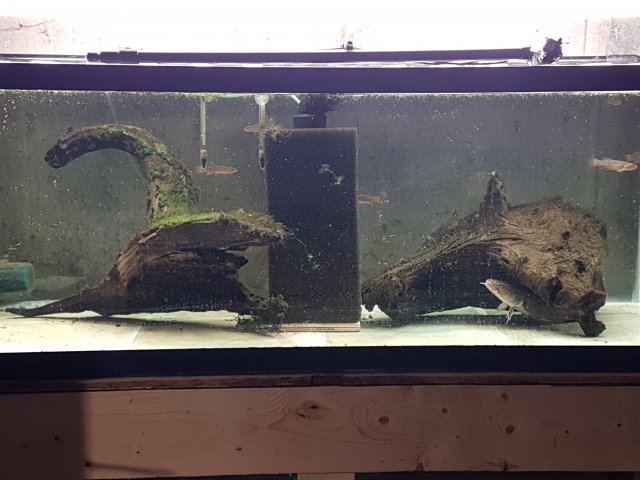Came downstairs this morning, and found that I had forgotten to deprogram the light timer so the tank lights were on for their morning 3-hour rotation. The burbot was sinuously travelling around the well-lit and sparsely furnished tank, poking into every nook and cranny...and 2 mudminnows have vanished. 
Sadly, I took one step to centre myself in front of the tank, pulled out my phone...and this disturbance caused him to return to what is becoming his favourite lair under a piece of wood. This was intended to be a full-tank shot with the fish on display, front and centre; oh, well...
His vision seems excellent, far superior to most catfish species. As a bonus, he is not as bottom-oriented as I expected. He rests on the bottom, but when in motion he is at all levels, and has been observed moving along the glass right at the surface, exploring the limits of the tank. His overall behaviour so far is very reminiscent of an Ornate Polypterus I had years ago. I'm sure that in nature, he is sticking close to the bottom...in the deep water the adults inhabit. In an 18-inch deep tank, he is...so far, at least...everywhere. This tank cover is remaining on.
I'm carefully watching the corner of his mouth, where he was hooked. We use only barbless hooks in Manitoba, so removal was quick and easy. I have brought home many fish caught on hooks (even barbed hooks, back in Ontario) and have never had any problems develop at the hooksite as long as it is near the mouth opening, so I expect none here, but the warnings about susceptibility to fungus have me on guard.

Sadly, I took one step to centre myself in front of the tank, pulled out my phone...and this disturbance caused him to return to what is becoming his favourite lair under a piece of wood. This was intended to be a full-tank shot with the fish on display, front and centre; oh, well...
His vision seems excellent, far superior to most catfish species. As a bonus, he is not as bottom-oriented as I expected. He rests on the bottom, but when in motion he is at all levels, and has been observed moving along the glass right at the surface, exploring the limits of the tank. His overall behaviour so far is very reminiscent of an Ornate Polypterus I had years ago. I'm sure that in nature, he is sticking close to the bottom...in the deep water the adults inhabit. In an 18-inch deep tank, he is...so far, at least...everywhere. This tank cover is remaining on.
I'm carefully watching the corner of his mouth, where he was hooked. We use only barbless hooks in Manitoba, so removal was quick and easy. I have brought home many fish caught on hooks (even barbed hooks, back in Ontario) and have never had any problems develop at the hooksite as long as it is near the mouth opening, so I expect none here, but the warnings about susceptibility to fungus have me on guard.

Last edited:


